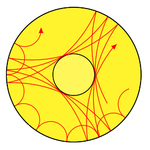- Asteroseismology
-
Asteroseismology (from Greek ἀστήρ, astēr, "star"; σεισμός, seismos, "earthquake"; and -λογία, -logia) also known as stellar seismology[1][2] is the science that studies the internal structure of pulsating stars by the interpretation of their frequency spectra. Different oscillation modes penetrate to different depths inside the star. These oscillations provide information about the otherwise unobservable interiors of stars in a manner similar to how seismologists study the interior of Earth and other solid planets through the use of earthquake oscillations.[2]
The oscillations studied by asteroseismologists are driven by thermal energy converted into kinetic energy of pulsation. This process is similar to what goes on with any heat engine, in which heat is absorbed in the high temperature phase of oscillation and emitted when the temperature is low. The main mechanism for stars is the net conversion of radiation energy into pulsational energy in the surface layers of some classes of stars. The resulting oscillations are usually studied under the assumption that they are small, and that the star is isolated and spherically symmetric. In binary star systems, stellar tides can also have a significant influence on the star's oscillations. One application of asteroseismology is neutron stars, whose inner structure cannot be directly observed, but may be possible to infer through studies of neutron-star oscillations.[citation needed]
Helioseismology, also known as Solar seismology, is the closely related field of study focused on the Sun. Oscillations in the Sun are excited by convection in its outer layers, and observing solar-like oscillations in other stars is a new and expanding area of asteroseismology.
Asteroseismology provides the tool to find the internal structure of stars. The pulsation frequencies give the information about the density profile of the region where the waves originate and travel. The spectrum gives the information about its chemical constituents. Both can be used to give information about the internal structure.
Waves in sun-like stars can be divided into three different types;[3]
- Acoustic or pressure (p) modes,[2] driven by internal pressure fluctuations within a star; their dynamics being determined by the local speed of sound.
- Gravity (g) modes, driven by buoyancy,[4]
- Surface gravity (f) modes, akin to ocean waves along the stellar surface.[5]
Within a sun-like star, such as Alpha Centauri, the p-modes are the most prominent as the g-modes are essentially confined to the core by the convection zone. However, g-modes have been observed in white dwarf stars.[4]
Space missions
A number of active spacecraft have asteroseismology studies as a significant part of their mission.
- MOST - A Canadian satellite launched in 2003. The first spacecraft dedicated to asteroseismology.
- COROT - A French led ESA planet-finder and asteroseismology satellite launched in 2006
- WIRE - A NASA satellite launched in 1999. A failed infrared telescope now used for asteroseismology.
- SOHO - A joint ESA / NASA spacecraft launched in 1995 to study the Sun.
- Kepler - A NASA planet-finder spacecraft launched in 2009 that is currently making asteroseismology studies of over a thousand stars in its field, including the now well-studied subgiant KIC 11026764.[6][7]
References
- ^ BBC. Team records 'music' from stars. 2008-10-23. Retrieved 2008-10-24
- ^ a b c David Guenther. Saint Mary's University. Retrieved 2008-10-24
- ^ Unno, W., Osaki, Y., Ando, H., Saio, H., Shibahashi, H., 1989, Nonradial Oscillations of Stars, University of Tokyo Press, Tokyo, Japan, 2nd edn.
- ^ a b Jørgen Christensen-Dalsgaard. Lecture Notes on Stellar Oscillations - Chapter 1. Fifth Edition. June 2003. (PDF format) Page 3. Retrieved 2008-10-24
- ^ Jørgen Christensen-Dalsgaard. Lecture Notes on Stellar Oscillations - Chapter 2. Fifth Edition. June 2003. (PDF format) Page 23. Retrieved 2008-10-24
- ^ Metcalfe, T. S.; et al (2010-10-25). "A Precise Asteroseismic Age and Radius for the Evolved Sun-like Star KIC 11026764". The Astrophysical Journal 723 (2): 1583. Bibcode 2010ApJ...723.1583M. doi:10.1088/0004-637X/723/2/1583.
- ^ "Graphics for 2010 Oct 26 webcast - Images from the Kepler Asteroseismology Science Consortium (KASC) webcast of 2010 Oct 26". NASA. 2010-10-26. http://kepler.nasa.gov/news/nasakeplernews/20101026webcast/. Retrieved 3 November 2010.
External links
- Asteroseismology.org
- Stellar Oscillations Network Group (SONG)
- European Helio- and Asteroseismology Network (HELAS)
Categories:- Fields of seismology
- Astrophysics
- Stellar phenomena
Wikimedia Foundation. 2010.

